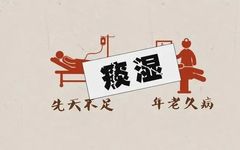The phlegm-damp constitution refers to a physical state characterized by the accumulation of phlegm and dampness in the body, primarily manifested as a tendency towards obesity, and symptoms such as heaviness and turbidity.The phlegm-damp constitution is a normal physiological state, not a pathological state, nor a healthy state; individuals with this constitution are in a sub-healthy state between pathological and non-pathological.The formation of the phlegm-damp constitution is related to factors such as invasion by external pathogens, congenital endowment, irregular diet, and emotional disturbances. If early intervention is applied to the phlegm-damp constitution, it can effectively reduce the incidence of related diseases; if not adjusted in time, it can easily lead to diseases such as diabetes, stroke, dizziness, cough and asthma, gout, hypertension, and coronary heart disease.Characteristics of Phlegm-Damp ConstitutionIndividuals with a phlegm-damp constitution have decreased metabolic capacity, leading to the accumulation of “phlegm” and “dampness” in the body, resulting in internal “garbage accumulation,” and externally manifested as obesity, sticky sweating, and snoring during sleep.There are five main characteristics of phlegm-damp constitution:1Body ShapeA typical manifestation of individuals with a phlegm-damp constitution is abdominal obesity, characterized by soft and loose fat in the abdomen. This is due to the accumulation of “garbage” in the body, which is reflected in oily skin on the face and obesity in body shape. Many individuals with this constitution exhibit abdominal obesity, with a significant amount of soft fat in the abdomen.
If early intervention is applied to the phlegm-damp constitution, it can effectively reduce the incidence of related diseases; if not adjusted in time, it can easily lead to diseases such as diabetes, stroke, dizziness, cough and asthma, gout, hypertension, and coronary heart disease.Characteristics of Phlegm-Damp ConstitutionIndividuals with a phlegm-damp constitution have decreased metabolic capacity, leading to the accumulation of “phlegm” and “dampness” in the body, resulting in internal “garbage accumulation,” and externally manifested as obesity, sticky sweating, and snoring during sleep.There are five main characteristics of phlegm-damp constitution:1Body ShapeA typical manifestation of individuals with a phlegm-damp constitution is abdominal obesity, characterized by soft and loose fat in the abdomen. This is due to the accumulation of “garbage” in the body, which is reflected in oily skin on the face and obesity in body shape. Many individuals with this constitution exhibit abdominal obesity, with a significant amount of soft fat in the abdomen. Due to the high levels of phlegm and dampness in the body, individuals with a phlegm-damp constitution may feel uncomfortable and find it difficult to adapt during external rainy weather (such as the plum rain season in the south).2DietIndividuals with a phlegm-damp constitution generally have a good appetite and enjoy eating, especially favoring fatty, sweet, and oily foods. These foods turn into greasy fats that accumulate in the body, and the body cannot clear the “garbage” quickly enough, leading to further accumulation.3SleepIndividuals with a phlegm-damp constitution are prone to loud snoring during sleep, which can be described as “thunderous.” Particularly, those weighing over 90 kilograms may experience breathing difficulties during sleep, known medically as “sleep apnea syndrome,” which can be fatal for many.
Due to the high levels of phlegm and dampness in the body, individuals with a phlegm-damp constitution may feel uncomfortable and find it difficult to adapt during external rainy weather (such as the plum rain season in the south).2DietIndividuals with a phlegm-damp constitution generally have a good appetite and enjoy eating, especially favoring fatty, sweet, and oily foods. These foods turn into greasy fats that accumulate in the body, and the body cannot clear the “garbage” quickly enough, leading to further accumulation.3SleepIndividuals with a phlegm-damp constitution are prone to loud snoring during sleep, which can be described as “thunderous.” Particularly, those weighing over 90 kilograms may experience breathing difficulties during sleep, known medically as “sleep apnea syndrome,” which can be fatal for many. Additionally, individuals with a phlegm-damp constitution often have poor spleen and stomach function, leading to drowsiness after meals. It can be said that they tend to feel sleepy and love to sleep, but once asleep, they snore and experience sleep apnea, which is quite concerning.4Psychological StateIndividuals with a phlegm-damp constitution generally have a gentle personality, are calm in their actions, and are relatively stable and good-tempered. A word that vividly summarizes their personality traits is “steady as Mount Tai.”5ExcretionIndividuals with a phlegm-damp constitution tend to sweat in a sticky manner, and their stools are often loose and unformed. Some may also experience constipation due to the obstruction of gastrointestinal motility by phlegm and dampness.How to Regulate Phlegm-Damp ConstitutionIndividuals with a phlegm-damp constitution often have stagnant fluids and accumulated phlegm, so the regulation method focuses on resolving phlegm and eliminating dampness, while also strengthening the spleen and aiding transportation.
Additionally, individuals with a phlegm-damp constitution often have poor spleen and stomach function, leading to drowsiness after meals. It can be said that they tend to feel sleepy and love to sleep, but once asleep, they snore and experience sleep apnea, which is quite concerning.4Psychological StateIndividuals with a phlegm-damp constitution generally have a gentle personality, are calm in their actions, and are relatively stable and good-tempered. A word that vividly summarizes their personality traits is “steady as Mount Tai.”5ExcretionIndividuals with a phlegm-damp constitution tend to sweat in a sticky manner, and their stools are often loose and unformed. Some may also experience constipation due to the obstruction of gastrointestinal motility by phlegm and dampness.How to Regulate Phlegm-Damp ConstitutionIndividuals with a phlegm-damp constitution often have stagnant fluids and accumulated phlegm, so the regulation method focuses on resolving phlegm and eliminating dampness, while also strengthening the spleen and aiding transportation.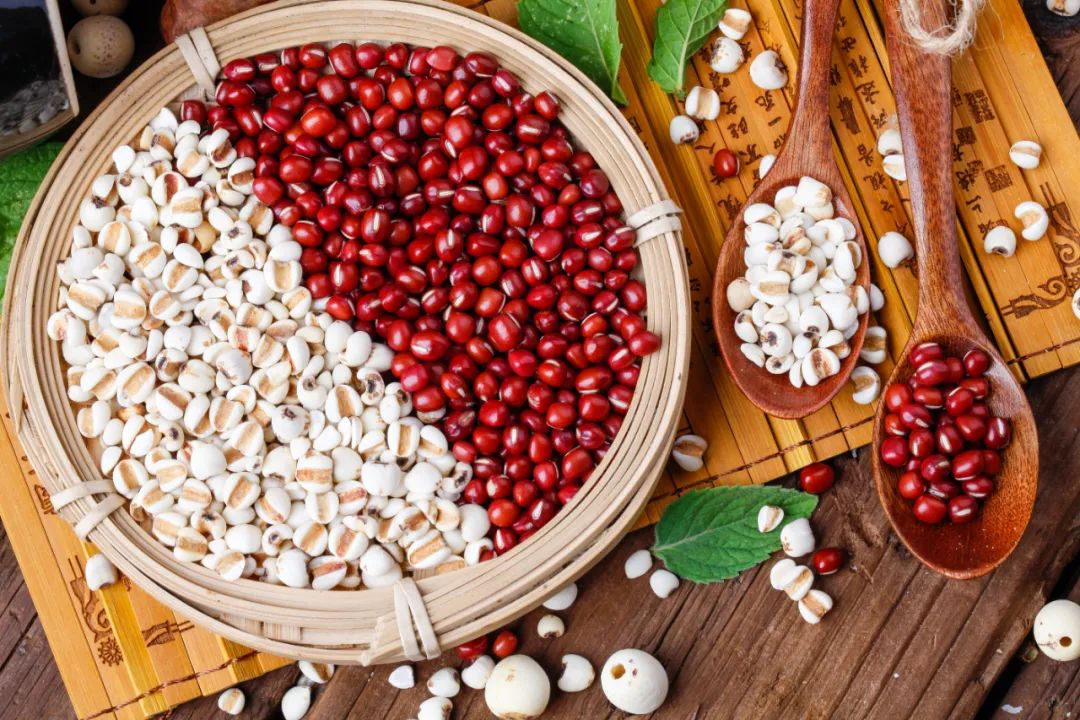 1Dietary RegulationIndividuals with a phlegm-damp constitution should choose foods that strengthen the spleen and aid transportation, and eliminate dampness and phlegm. They should avoid fatty, sweet, oily, and sticky foods. Meals should not be too full; eating until 70% full is recommended, and binge eating and eating too quickly should be avoided.Recommended aquatic products include carp, crucian carp, bass, kelp, jellyfish, and clams. Grains and legumes such as lentils, coix seeds, red adzuki beans, and yam are also beneficial, as well as fruits and vegetables like winter melon, lotus leaves, white radish, ginger, shepherd’s purse, and nori.Coix Seed: It is cool in nature, sweet and bland in taste, enters the spleen, lung, and kidney meridians, and has the effects of promoting urination, strengthening the spleen, dispelling dampness, and clearing heat and pus. Due to its mild action and slight coldness, it does not harm the stomach and benefits the spleen without being greasy, making it suitable for daily consumption by those with a phlegm-damp constitution.
1Dietary RegulationIndividuals with a phlegm-damp constitution should choose foods that strengthen the spleen and aid transportation, and eliminate dampness and phlegm. They should avoid fatty, sweet, oily, and sticky foods. Meals should not be too full; eating until 70% full is recommended, and binge eating and eating too quickly should be avoided.Recommended aquatic products include carp, crucian carp, bass, kelp, jellyfish, and clams. Grains and legumes such as lentils, coix seeds, red adzuki beans, and yam are also beneficial, as well as fruits and vegetables like winter melon, lotus leaves, white radish, ginger, shepherd’s purse, and nori.Coix Seed: It is cool in nature, sweet and bland in taste, enters the spleen, lung, and kidney meridians, and has the effects of promoting urination, strengthening the spleen, dispelling dampness, and clearing heat and pus. Due to its mild action and slight coldness, it does not harm the stomach and benefits the spleen without being greasy, making it suitable for daily consumption by those with a phlegm-damp constitution.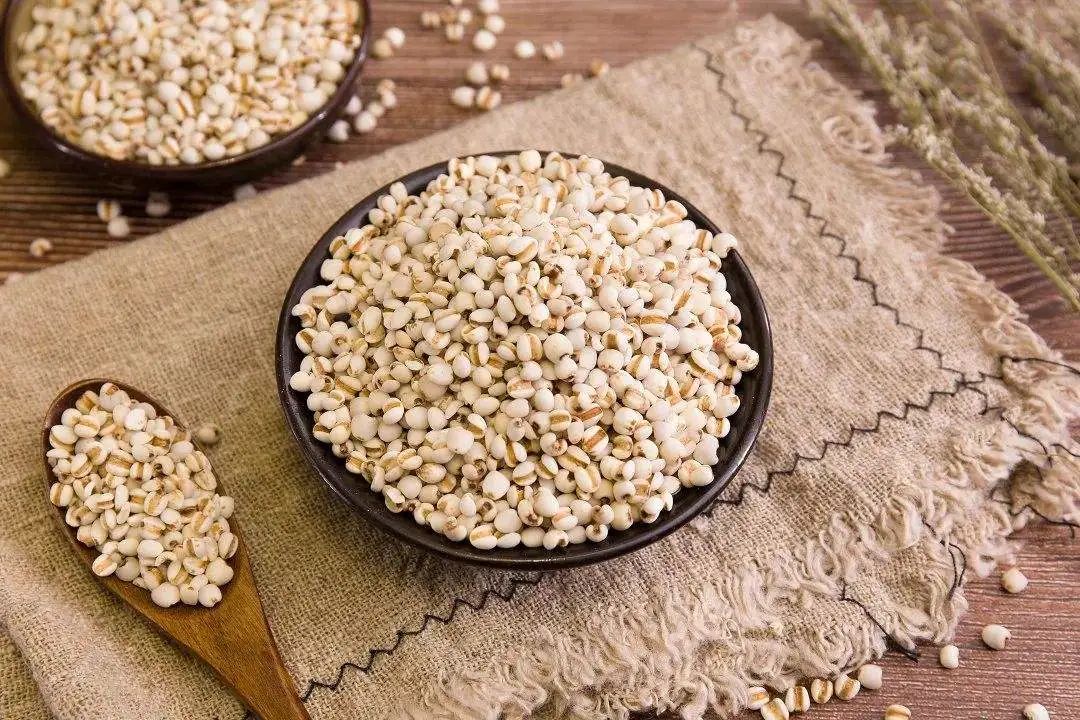 Carp: It is sweet in taste and neutral in nature, enters the spleen and kidney meridians, and has the effects of tonifying the spleen, strengthening the stomach, promoting urination, and reducing swelling. The “Compendium of Materia Medica” states: “Carp is particularly effective in promoting urination, thus alleviating swelling, jaundice, beriberi, cough, and damp-heat diseases, and it helps to clear water retention and promote urination.” It is suitable for individuals with a phlegm-damp constitution.Lentils: They are sweet in taste and neutral in nature, entering the spleen and stomach meridians, and have the effects of strengthening the spleen and stomach, dispelling summer heat, and transforming dampness. The “Compendium of Materia Medica” states: “Hard-shelled white lentils are solid, white with a slight yellow hue, have a fragrant smell, and are warm and neutral in nature, suitable for the spleen.” They can clear and lower turbidity, thus treating abdominal fullness and dispelling summer heat and detoxifying. They are suitable for those with a phlegm-damp constitution who experience abdominal distension.
Carp: It is sweet in taste and neutral in nature, enters the spleen and kidney meridians, and has the effects of tonifying the spleen, strengthening the stomach, promoting urination, and reducing swelling. The “Compendium of Materia Medica” states: “Carp is particularly effective in promoting urination, thus alleviating swelling, jaundice, beriberi, cough, and damp-heat diseases, and it helps to clear water retention and promote urination.” It is suitable for individuals with a phlegm-damp constitution.Lentils: They are sweet in taste and neutral in nature, entering the spleen and stomach meridians, and have the effects of strengthening the spleen and stomach, dispelling summer heat, and transforming dampness. The “Compendium of Materia Medica” states: “Hard-shelled white lentils are solid, white with a slight yellow hue, have a fragrant smell, and are warm and neutral in nature, suitable for the spleen.” They can clear and lower turbidity, thus treating abdominal fullness and dispelling summer heat and detoxifying. They are suitable for those with a phlegm-damp constitution who experience abdominal distension.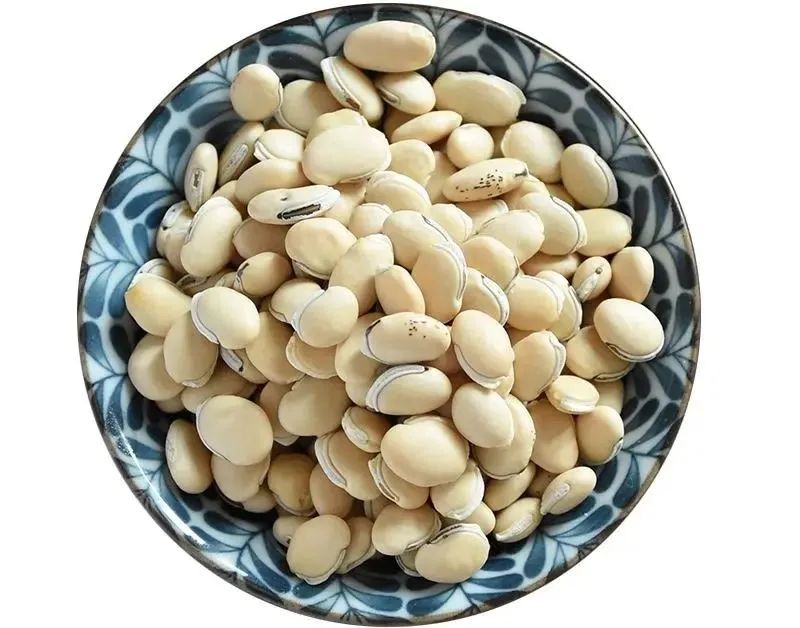 Red Adzuki Bean: It is neutral in nature, sweet and sour in taste, enters the heart and liver meridians, and has the effects of promoting urination, reducing swelling, detoxifying, and expelling pus. Modern research has shown that red adzuki beans contain saponins, which have laxative, diuretic, and swelling-reducing effects, and can detoxify and relieve hangovers. They are suitable for those with a phlegm-damp constitution and those prone to edema.White Radish: It is cool in nature, sweet in taste, enters the lung and stomach meridians, and has the effects of promoting digestion, transforming accumulation, clearing heat, and resolving phlegm. Modern studies have found that regular consumption can lower blood lipids and blood pressure, and aid in weight loss. It is suitable for individuals with a phlegm-damp constitution who are obese and have excessive phlegm.Winter Melon: It is sweet and bland, cool in nature, enters the lung, large intestine, and bladder meridians, and has the functions of promoting urination, reducing swelling, transforming phlegm, and lowering lipids. The “Shennong’s Classic of Materia Medica” states that it can “lighten the body and resist aging”.
Red Adzuki Bean: It is neutral in nature, sweet and sour in taste, enters the heart and liver meridians, and has the effects of promoting urination, reducing swelling, detoxifying, and expelling pus. Modern research has shown that red adzuki beans contain saponins, which have laxative, diuretic, and swelling-reducing effects, and can detoxify and relieve hangovers. They are suitable for those with a phlegm-damp constitution and those prone to edema.White Radish: It is cool in nature, sweet in taste, enters the lung and stomach meridians, and has the effects of promoting digestion, transforming accumulation, clearing heat, and resolving phlegm. Modern studies have found that regular consumption can lower blood lipids and blood pressure, and aid in weight loss. It is suitable for individuals with a phlegm-damp constitution who are obese and have excessive phlegm.Winter Melon: It is sweet and bland, cool in nature, enters the lung, large intestine, and bladder meridians, and has the functions of promoting urination, reducing swelling, transforming phlegm, and lowering lipids. The “Shennong’s Classic of Materia Medica” states that it can “lighten the body and resist aging”.
In the Tang Dynasty, dietary therapy expert Meng Shen believed that winter melon can “benefit qi and resist aging” and pointed out that “to achieve a slim and healthy body, one should consume it regularly; if one desires to gain weight, then one should avoid it.” This indicates that winter melon not only has anti-aging effects but also aids in weight loss. It is suitable for individuals with a phlegm-damp constitution who experience eyelid swelling and obesity.
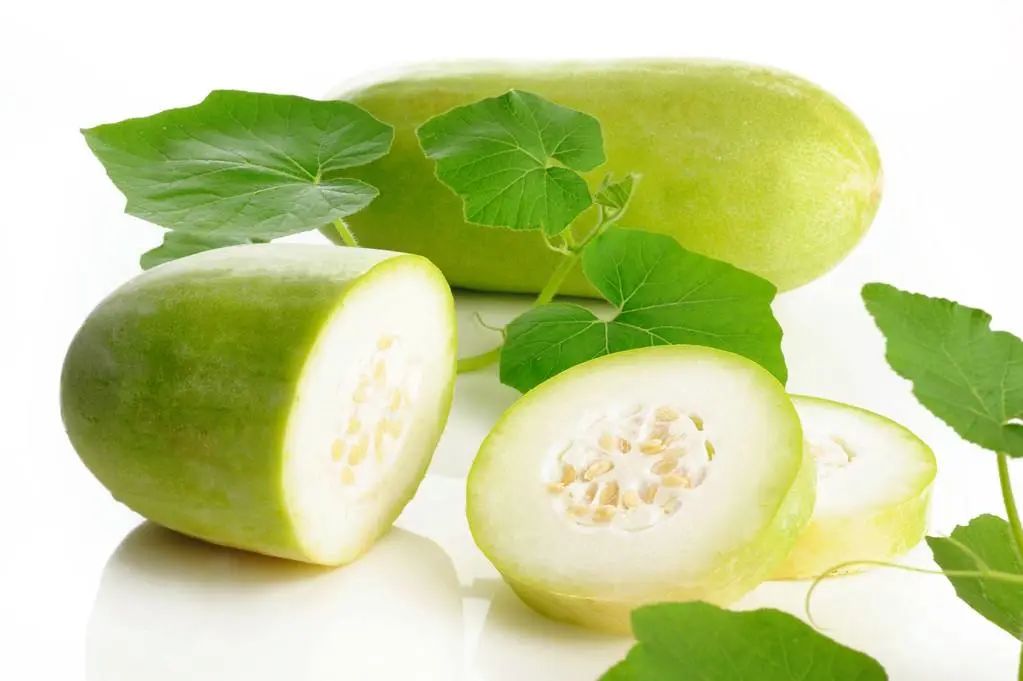
Seaweed: It is sweet and salty, cold in nature, enters the lung meridian, and has the effects of resolving phlegm, softening hardness, clearing heat, and promoting urination. It is suitable for individuals with a phlegm-damp constitution and those who are healthy.Lotus Leaf: It is bitter and astringent, neutral in nature, enters the heart, liver, and spleen meridians, and has the effects of clearing heat, eliminating dampness, and uplifting clear yang. The “Compendium of Materia Medica” records that lotus leaf “uplifts yang qi and reduces fat and weight.” It is suitable for individuals with a phlegm-damp constitution who have a tendency towards high blood lipids.2Physical ExerciseExercise should be sustained. Individuals with a phlegm-damp constitution tend to be overweight and easily fatigued, so they should gradually increase their exercise based on their specific conditions and maintain a long-term exercise regimen. Physical fitness methods suitable for simple obesity are also suitable for those with a phlegm-damp constitution, such as walking, jogging, playing table tennis, badminton, tennis, swimming, practicing martial arts, and various forms of dance that suit them. Individuals with a phlegm-damp constitution should enhance their metabolic processes and engage in prolonged aerobic exercise to gradually firm and tighten their loose flesh.Moderate-intensity, longer-duration full-body exercises are considered aerobic exercise.Generally, warm-up for about 15 minutes, then gradually increase the intensity, with an optimal exercise duration of 1 hour.Exercise should be done between 2:00 PM and 4:00 PM, when yang qi is at its peak, and the exercise environment should be warm and pleasant. Individuals with a phlegm-damp constitution generally have higher body weight, so they should pay attention to the pace of exercise and gradually increase their training to ensure safety.For those with significantly high body weight and poor land-based exercise capacity, swimming is recommended. Swimming is an excellent full-body exercise and a great method for weight loss, and it is very effective in improving cardiovascular function.
Individuals with a phlegm-damp constitution should enhance their metabolic processes and engage in prolonged aerobic exercise to gradually firm and tighten their loose flesh.Moderate-intensity, longer-duration full-body exercises are considered aerobic exercise.Generally, warm-up for about 15 minutes, then gradually increase the intensity, with an optimal exercise duration of 1 hour.Exercise should be done between 2:00 PM and 4:00 PM, when yang qi is at its peak, and the exercise environment should be warm and pleasant. Individuals with a phlegm-damp constitution generally have higher body weight, so they should pay attention to the pace of exercise and gradually increase their training to ensure safety.For those with significantly high body weight and poor land-based exercise capacity, swimming is recommended. Swimming is an excellent full-body exercise and a great method for weight loss, and it is very effective in improving cardiovascular function. 3Mental RegulationMaintain a positive mindset, and uplifting music can be invigorating. Individuals with a phlegm-damp constitution have gentle personalities, are stable in their actions, and are often good at being patient. However, due to the internal accumulation of phlegm and dampness, which obstructs yang qi, they are prone to feelings of fatigue. Therefore, they should enhance their exercise, participate in social activities, and cultivate a wide range of interests and hobbies.They can also listen to some upbeat and lively music, such as Strauss’s waltz series, Bizet’s Carmen Overture, Radetzky March, and the Erhu piece “Horse Racing.”4Daily CareAvoid dampness in daily life. Individuals with a phlegm-damp constitution are characterized by excessive dampness and should not stay in damp environments for long. During rainy seasons, they should be cautious to avoid dampness invasion, and in humid and cold weather, they should reduce outdoor activities to avoid catching a cold or getting wet. Dampness is heavy and turbid, easily obstructing qi movement and harming yang qi.
3Mental RegulationMaintain a positive mindset, and uplifting music can be invigorating. Individuals with a phlegm-damp constitution have gentle personalities, are stable in their actions, and are often good at being patient. However, due to the internal accumulation of phlegm and dampness, which obstructs yang qi, they are prone to feelings of fatigue. Therefore, they should enhance their exercise, participate in social activities, and cultivate a wide range of interests and hobbies.They can also listen to some upbeat and lively music, such as Strauss’s waltz series, Bizet’s Carmen Overture, Radetzky March, and the Erhu piece “Horse Racing.”4Daily CareAvoid dampness in daily life. Individuals with a phlegm-damp constitution are characterized by excessive dampness and should not stay in damp environments for long. During rainy seasons, they should be cautious to avoid dampness invasion, and in humid and cold weather, they should reduce outdoor activities to avoid catching a cold or getting wet. Dampness is heavy and turbid, easily obstructing qi movement and harming yang qi. Therefore, the living environment should be warm and dry, rather than cold and damp. Clothing should be breathable to dissipate moisture, primarily made of natural fibers such as cotton, linen, and silk, which facilitate sweat evaporation and eliminate internal dampness. At the same time, attention should be paid to warmth. Individuals with a phlegm-damp constitution should frequently take hot baths, to the extent that their skin slightly reddens and they sweat all over.Those with a phlegm-damp constitution tend to be sleepy, so they should appropriately reduce their sleep duration, avoid excessive comfort, and not be overly attached to their beds. When sleeping, pillows should not be too high to prevent worsening snoring; they should engage in more outdoor activities to keep their bodily functions active.Encourage individuals with a phlegm-damp constitution to participate in group travel, hiking, and other activities to increase outdoor exercise and promote yang qi and qi movement. They should also regularly monitor their blood sugar, blood lipids, and blood pressure.
Therefore, the living environment should be warm and dry, rather than cold and damp. Clothing should be breathable to dissipate moisture, primarily made of natural fibers such as cotton, linen, and silk, which facilitate sweat evaporation and eliminate internal dampness. At the same time, attention should be paid to warmth. Individuals with a phlegm-damp constitution should frequently take hot baths, to the extent that their skin slightly reddens and they sweat all over.Those with a phlegm-damp constitution tend to be sleepy, so they should appropriately reduce their sleep duration, avoid excessive comfort, and not be overly attached to their beds. When sleeping, pillows should not be too high to prevent worsening snoring; they should engage in more outdoor activities to keep their bodily functions active.Encourage individuals with a phlegm-damp constitution to participate in group travel, hiking, and other activities to increase outdoor exercise and promote yang qi and qi movement. They should also regularly monitor their blood sugar, blood lipids, and blood pressure. 5Acupuncture and MassageSelected Points: Fenglong (ST40), Zusanli (ST36).Fenglong is located at the midpoint of the line connecting the outer knee eye (Xiyan) and the outer ankle tip, 2 fingerbreadths lateral to the anterior crest of the tibia. The point can be accessed while sitting with the knee flexed or lying supine.Zusanli is located 4 fingerbreadths below the outer knee eye, 1 fingerbreadth lateral to the edge of the tibia, accessed while sitting with the knee flexed.Effects: Fenglong is a point on the stomach meridian, connecting with the spleen meridian, and can regulate the spleen and stomach, serving as a key point for resolving phlegm, with effects of eliminating dampness and phlegm. Zusanli is the lower he-sea point of the stomach, which has the effects of tonifying the spleen and stomach and resolving phlegm.
5Acupuncture and MassageSelected Points: Fenglong (ST40), Zusanli (ST36).Fenglong is located at the midpoint of the line connecting the outer knee eye (Xiyan) and the outer ankle tip, 2 fingerbreadths lateral to the anterior crest of the tibia. The point can be accessed while sitting with the knee flexed or lying supine.Zusanli is located 4 fingerbreadths below the outer knee eye, 1 fingerbreadth lateral to the edge of the tibia, accessed while sitting with the knee flexed.Effects: Fenglong is a point on the stomach meridian, connecting with the spleen meridian, and can regulate the spleen and stomach, serving as a key point for resolving phlegm, with effects of eliminating dampness and phlegm. Zusanli is the lower he-sea point of the stomach, which has the effects of tonifying the spleen and stomach and resolving phlegm.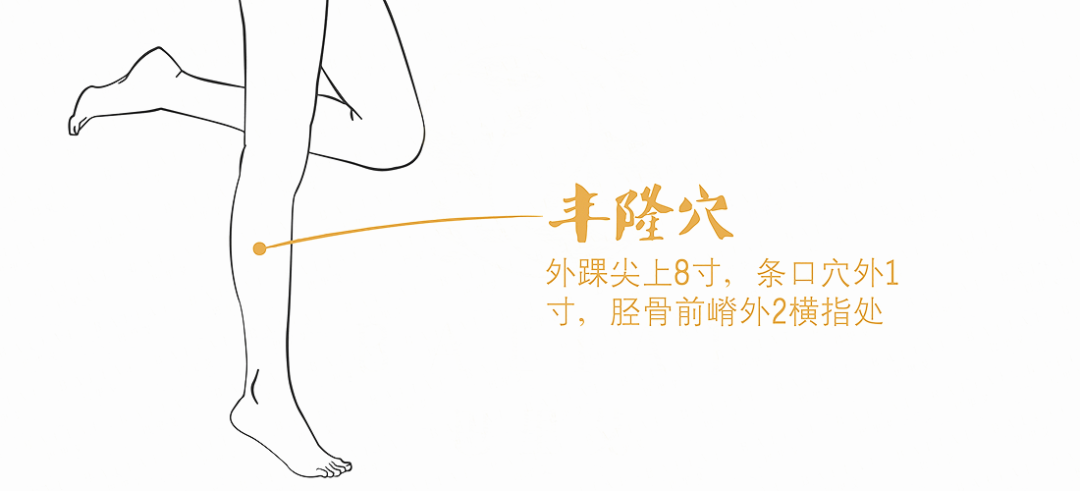 Procedure: Use gentle finger pressure, guasha, or moxibustion methods. Each acupoint should be pressed for 2-3 minutes, performed 1-2 times daily. Moxibustion should be applied for 10 minutes at each point, once daily.Examples of Medicinal Dishes1Yam and Winter Melon SoupIngredients: 50g yam, 150g winter melon.Preparation: Place yam and winter melon in a pot and simmer on low heat for 30 minutes, seasoning before consumption.Effects: Strengthens the spleen, benefits qi, and eliminates dampness. Suitable for individuals with a phlegm-damp constitution, especially those with simple obesity.
Procedure: Use gentle finger pressure, guasha, or moxibustion methods. Each acupoint should be pressed for 2-3 minutes, performed 1-2 times daily. Moxibustion should be applied for 10 minutes at each point, once daily.Examples of Medicinal Dishes1Yam and Winter Melon SoupIngredients: 50g yam, 150g winter melon.Preparation: Place yam and winter melon in a pot and simmer on low heat for 30 minutes, seasoning before consumption.Effects: Strengthens the spleen, benefits qi, and eliminates dampness. Suitable for individuals with a phlegm-damp constitution, especially those with simple obesity.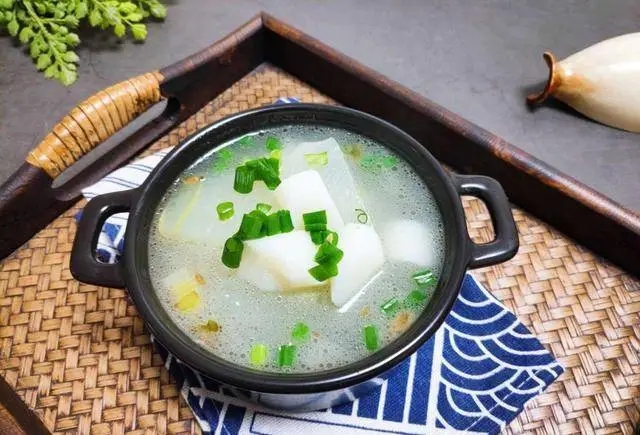 2Coix Seed PorridgeIngredients: 50g raw coix seed, 60g japonica rice.Preparation: Place raw coix seed and japonica rice in a pot, boil on high heat, then simmer for 2 hours, adding an appropriate amount of white sugar for flavor.Effects: Eliminates dampness and phlegm, strengthens the spleen, and benefits qi. Suitable for individuals with a phlegm-damp constitution or those with damp-heat constitution, especially those with obesity.3Fat-Reducing TeaIngredients: 30g poria, 30g roasted coix seed, 30g dried lotus leaf, 15g dried tangerine peel, 15g fresh hawthorn, 10g cinnamon (added last).
2Coix Seed PorridgeIngredients: 50g raw coix seed, 60g japonica rice.Preparation: Place raw coix seed and japonica rice in a pot, boil on high heat, then simmer for 2 hours, adding an appropriate amount of white sugar for flavor.Effects: Eliminates dampness and phlegm, strengthens the spleen, and benefits qi. Suitable for individuals with a phlegm-damp constitution or those with damp-heat constitution, especially those with obesity.3Fat-Reducing TeaIngredients: 30g poria, 30g roasted coix seed, 30g dried lotus leaf, 15g dried tangerine peel, 15g fresh hawthorn, 10g cinnamon (added last). Preparation: Prepare one dose daily, decoct twice, mix the liquid after removing the dregs, and store in a thermos for drinking at any time.Effects: Resolves phlegm and lowers turbidity, strengthens the spleen, and eliminates dampness. Especially suitable for individuals with a phlegm-damp constitution and those with a tendency towards high blood lipids.4Red Adzuki Bean and Carp SoupIngredients: 1 live carp (about 800g), 50g red adzuki beans, 10g dried tangerine peel, 6g chili, 6g grass fruit.Preparation: Scale, gut, and clean the live carp; fill the carp’s belly with red adzuki beans, dried tangerine peel, chili, and grass fruit, place in a bowl, add an appropriate amount of cooking wine, ginger, scallions, pepper, and a little salt, and steam until cooked.Effects: Eliminates dampness and phlegm, promotes urination, and reduces swelling. Suitable for individuals with a phlegm-damp constitution who often feel chest tightness, have excessive phlegm, dizziness, or edema.
Preparation: Prepare one dose daily, decoct twice, mix the liquid after removing the dregs, and store in a thermos for drinking at any time.Effects: Resolves phlegm and lowers turbidity, strengthens the spleen, and eliminates dampness. Especially suitable for individuals with a phlegm-damp constitution and those with a tendency towards high blood lipids.4Red Adzuki Bean and Carp SoupIngredients: 1 live carp (about 800g), 50g red adzuki beans, 10g dried tangerine peel, 6g chili, 6g grass fruit.Preparation: Scale, gut, and clean the live carp; fill the carp’s belly with red adzuki beans, dried tangerine peel, chili, and grass fruit, place in a bowl, add an appropriate amount of cooking wine, ginger, scallions, pepper, and a little salt, and steam until cooked.Effects: Eliminates dampness and phlegm, promotes urination, and reduces swelling. Suitable for individuals with a phlegm-damp constitution who often feel chest tightness, have excessive phlegm, dizziness, or edema.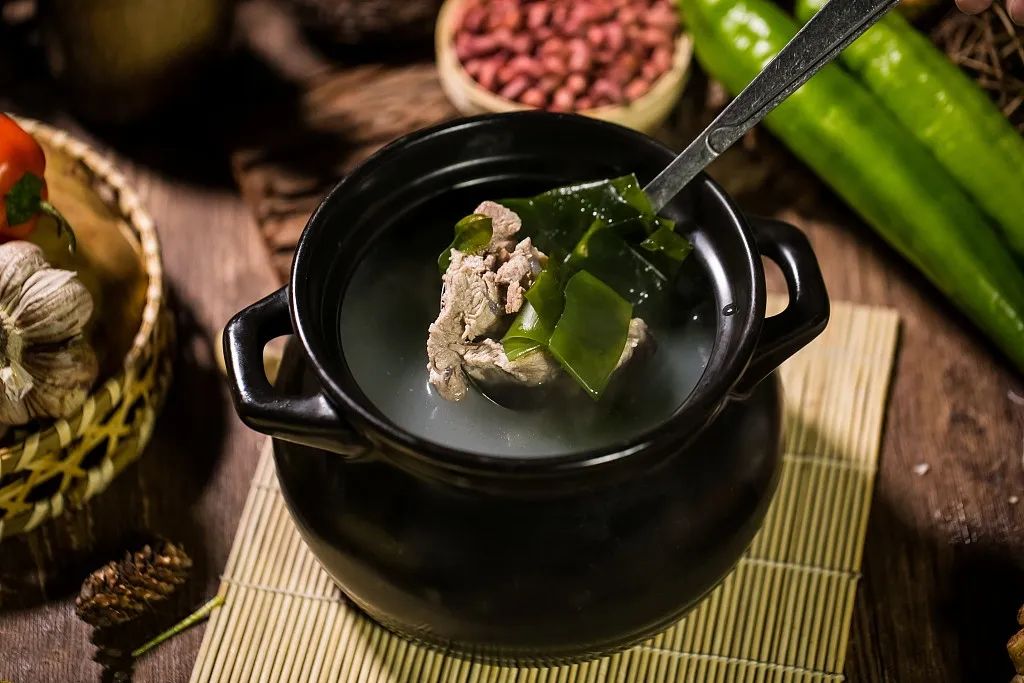 5Kombu and Seaweed Pork Rib SoupIngredients: 40g kombu, 40g seaweed, 500g pork ribs, 2-3 slices of ginger.Preparation: Clean the kombu and seaweed, soak for 30 minutes; clean and chop the pork ribs, then place them with ginger in a clay pot, add 3000ml of water (about 12 bowls), bring to a boil over high heat, then simmer for 3.5 hours, seasoning with salt and a little oil.Effects: Softens hardness and resolves phlegm. Suitable for individuals with a phlegm-damp constitution who have a tendency towards elevated blood pressure and experience dizziness.6Crucian Carp and Tofu SoupIngredients: 250g crucian carp, 250g tofu, 2 slices of ginger, scallions, cooking wine, salt, cooking oil, and starch as needed.
5Kombu and Seaweed Pork Rib SoupIngredients: 40g kombu, 40g seaweed, 500g pork ribs, 2-3 slices of ginger.Preparation: Clean the kombu and seaweed, soak for 30 minutes; clean and chop the pork ribs, then place them with ginger in a clay pot, add 3000ml of water (about 12 bowls), bring to a boil over high heat, then simmer for 3.5 hours, seasoning with salt and a little oil.Effects: Softens hardness and resolves phlegm. Suitable for individuals with a phlegm-damp constitution who have a tendency towards elevated blood pressure and experience dizziness.6Crucian Carp and Tofu SoupIngredients: 250g crucian carp, 250g tofu, 2 slices of ginger, scallions, cooking wine, salt, cooking oil, and starch as needed.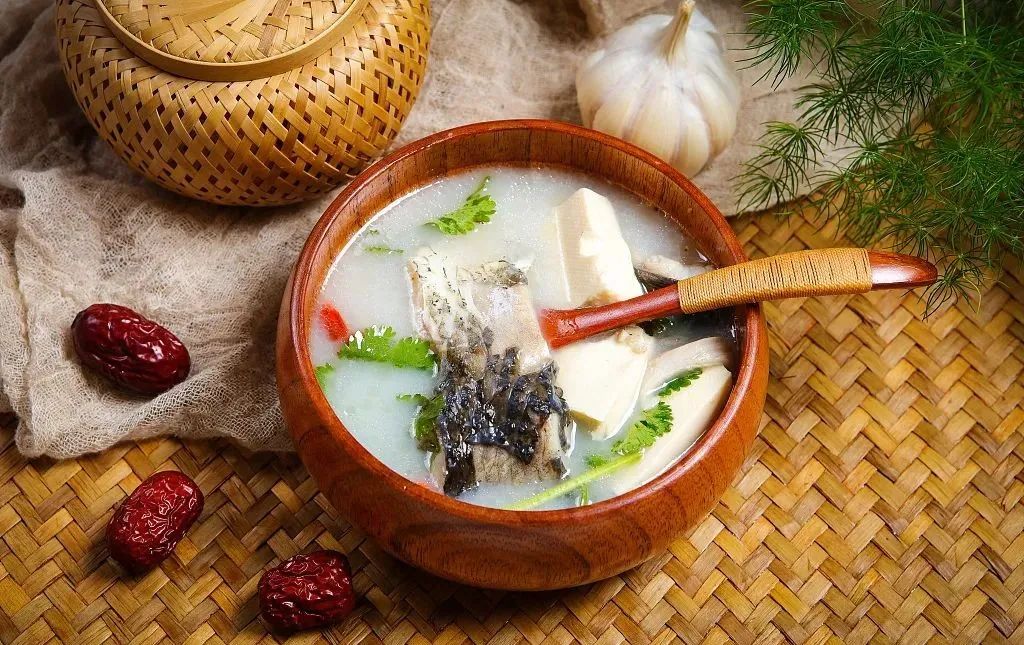 Preparation: Cut the tofu into thin slices and drain. Scale and gut the crucian carp, marinate with cooking wine and salt for 10 minutes. Heat oil in a pan, sauté ginger slices, then pan-fry the fish until golden on both sides, add an appropriate amount of water, and simmer for about 25 minutes, adding tofu slices, seasoning, and thickening with starch before garnishing with scallions.Effects: Strengthens the spleen, eliminates dampness, harmonizes the stomach, and stimulates appetite. Suitable for individuals with a phlegm-damp constitution who are prone to facial swelling and edema.
Preparation: Cut the tofu into thin slices and drain. Scale and gut the crucian carp, marinate with cooking wine and salt for 10 minutes. Heat oil in a pan, sauté ginger slices, then pan-fry the fish until golden on both sides, add an appropriate amount of water, and simmer for about 25 minutes, adding tofu slices, seasoning, and thickening with starch before garnishing with scallions.Effects: Strengthens the spleen, eliminates dampness, harmonizes the stomach, and stimulates appetite. Suitable for individuals with a phlegm-damp constitution who are prone to facial swelling and edema.

Copyright Statement: This article is reproduced from the internet. If there is any infringement, please contact us for deletion. The content is for reference and learning only, and should not be used as a prescription. Please do not use it blindly. This platform does not bear any responsibility for any consequences arising from this. We look forward to your original submissions at: [email protected]

